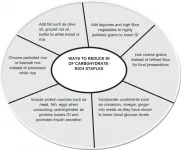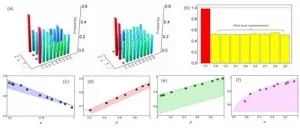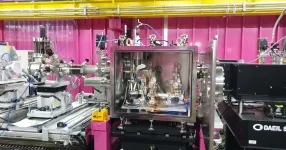(Press-News.org) If you've ever swatted a mosquito away from your face, only to have it return again (and again and again), you know that insects can be remarkably acrobatic and resilient in flight. Those traits help them navigate the aerial world, with all of its wind gusts, obstacles, and general uncertainty. Such traits are also hard to build into flying robots, but MIT Assistant Professor Kevin Yufeng Chen has built a system that approaches insects' agility.
Chen, a member of the Department of Electrical Engineering and Computer Science and the Research Laboratory of Electronics, has developed insect-sized drones with unprecedented dexterity and resilience. The aerial robots are powered by a new class of soft actuator, which allows them to withstand the physical travails of real-world flight. Chen hopes the robots could one day aid humans by pollinating crops or performing machinery inspections in cramped spaces.
Chen's work appears this month in the journal IEEE Transactions on Robotics. His co-authors include MIT PhD student Zhijian Ren, Harvard University PhD student Siyi Xu, and City University of Hong Kong roboticist Pakpong Chirarattananon.
Typically, drones require wide open spaces because they're neither nimble enough to navigate confined spaces nor robust enough to withstand collisions in a crowd. "If we look at most drones today, they're usually quite big," says Chen. "Most of their applications involve flying outdoors. The question is: Can you create insect-scale robots that can move around in very complex, cluttered spaces?"
According to Chen, "The challenge of building small aerial robots is immense." Pint-sized drones require a fundamentally different construction from larger ones. Large drones are usually powered by motors, but motors lose efficiency as you shrink them. So, Chen says, for insect-like robots "you need to look for alternatives."
The principal alternative until now has been employing a small, rigid actuator built from piezoelectric ceramic materials. While piezoelectric ceramics allowed the first generation of tiny robots to take flight, they're quite fragile. And that's a problem when you're building a robot to mimic an insect -- foraging bumblebees endure a collision about once every second.
Chen designed a more resilient tiny drone using soft actuators instead of hard, fragile ones. The soft actuators are made of thin rubber cylinders coated in carbon nanotubes. When voltage is applied to the carbon nanotubes, they produce an electrostatic force that squeezes and elongates the rubber cylinder. Repeated elongation and contraction causes the drone's wings to beat -- fast.
Chen's actuators can flap nearly 500 times per second, giving the drone insect-like resilience. "You can hit it when it's flying, and it can recover," says Chen. "It can also do aggressive maneuvers like somersaults in the air." And it weighs in at just 0.6 grams, approximately the mass of a large bumble bee. The drone looks a bit like a tiny cassette tape with wings, though Chen is working on a new prototype shaped like a dragonfly.
Building insect-like robots can provide a window into the biology and physics of insect flight, a longstanding avenue of inquiry for researchers. Chen's work addresses these questions through a kind of reverse engineering. "If you want to learn how insects fly, it is very instructive to build a scale robot model," he says. "You can perturb a few things and see how it affects the kinematics or how the fluid forces change. That will help you understand how those things fly." But Chen aims to do more than add to entomology textbooks. His drones can also be useful in industry and agriculture.
Chen says his mini-aerialists could navigate complex machinery to ensure safety and functionality. "Think about the inspection of a turbine engine. You'd want a drone to move around [an enclosed space] with a small camera to check for cracks on the turbine plates."
Other potential applications include artificial pollination of crops or completing search-and-rescue missions following a disaster. "All those things can be very challenging for existing large-scale robots," says Chen. Sometimes, bigger isn't better.
INFORMATION:
Written by Daniel Ackerman, MIT News Office
Paper: "Collision Resilient Insect-Scale Soft-Actuated Aerial Robots With High Agility"
https://ieeexplore.ieee.org/document/9357346
Green tea supplements modulate facial development of children with Down syndrome
A new study led by Belgian and Spanish researchers published in Scientific Reports adds evidence about the potential benefits of green tea extracts in Down syndrome. The researchers observed that the intake of green tea extracts can reduce facial dysmorphology in children with Down syndrome when taken during the first three years of life. Additional experimental research in mice confirmed the positive effects at low doses. However, they also found that high doses of the extract can disrupt facial and bone development. More research is needed to fully understand the effects of green tea extracts and therefore they should ...
Imagine a robot.
Perhaps you've just conjured a machine with a rigid, metallic exterior. While robots armored with hard exoskeletons are common, they're not always ideal. Soft-bodied robots, inspired by fish or other squishy creatures, might better adapt to changing environments and work more safely with people.
Roboticists generally have to decide whether to design a hard- or soft-bodied robot for a particular task. But that tradeoff may no longer be necessary.
Working with computer simulations, MIT researchers have developed a concept for a soft-bodied robot that can turn rigid on demand. The approach could enable a new generation of robots that combine the strength and precision of rigid robots with the fluidity and safety of ...
The models used to produce global climate scenarios may overestimate the energy and emission savings from improved energy efficiency, warns new research led by academics at the University of Sussex Business School and the University of Leeds.
In a review of 33 studies, the researchers find that economy wide rebound effects may erode around half of the energy and emission savings from improved energy efficiency.
These rebound effects result from individuals and businesses responding to the benefits of improved energy efficiency - such as cheaper heating, lighting and travel. These responses improve quality-of-life, raise productivity and boost industrial competitiveness, ...
Professor Christiani Jeyakumar Henry, Senior Advisor of Singapore Institute of Food and Biotechnology Innovation (SIFBI), Agency for Science, Technology and Research (A*STAR) and his team have developed a Glycaemic Index (GI) glossary of non-Western foods. The research paper (attached PDF) was published in Nutrition & Diabetes on 6 Jan 2021: https://doi.org/10.1038/s41387-020-00145-w.
Observational studies have shown that the consumption of low glycaemic index (GI) foods is associated with a lower risk of type 2 diabetes mellitus (T2DM), significantly less insulin resistance and a lower prevalence of the metabolic syndrome. ...
Recently, research team led by academician GUO Guangcan from CAS Key Laboratory of Quantum Information of the University of Science and Technology of China (USTC) of CAS, has made an important progress in quantum information theory. Prof. LI Chuanfeng and Prof. XIANG Guoyong from the team, cooperated with Dr. Strelstov from University of Warsaw, investigated the imaginary part of quantum theory as a resource, and several important results have been obtained. Relevant results are now jointly published as Editors' Suggestion in Physical Review Letters and Physical Review A.
Complex number is a mathematical ...
It is millions of trillions of times brighter than the sunlight and a whopping 1,000 trillionth of a second, appropriately called the instantaneous light. It is the X-ray Free Electron Laser (XFEL) light that opens a new scientific paradigm. Combining it with AI, an international research team has succeeded in filming and restoring the 3D structure of nanoparticles that share structural similarities with viruses. With the fear of a new pandemic growing around the world due to COVID-19, this discovery is attracting the attention among academic circles for imaging the structure of the virus with both high accuracy and speed.
An international team of researchers from POSTECH, National University of ...
Targeted, efficient and with few side effects: A new method for combating periodontitis could render the use of broad-spectrum antibiotics superfluous. It was developed and tested for the first time by a team from Martin Luther University Halle-Wittenberg (MLU), the Fraunhofer Institute for Cell Therapy and Immunology IZI and Periotrap Pharmaceuticals GmbH. The aim is to neutralise only bacteria that cause periodontitis while sparing harmless bacteria. The study appeared in the Journal of Biological Chemistry.
Periodontitis is a common bacterial inflammation of the gums. According to the World Health Organization WHO Oral ...
Ask Eric Weaver about pandemics, and he's quick to remind you of a fact that illustrates the fleeting nature of human memory and the proximal nature of human attention: The first pandemic of the 21st century struck not in 2019, but 2009.
That's when the H1N1/09 swine flu emerged, eventually infecting upwards of 1.4 billion people -- nearly one of every five on the planet at the time. True to the name, swine flus jump to humans from pigs. It's a phenomenon that has been documented more than 400 times since the mid-2000s in the United States alone.
"They're considered the great mixing vessel," said Weaver, associate professor of biological sciences at the University of Nebraska-Lincoln. "They're susceptible to their own circulating ...
Parents who reported more hassles using a child car seat or booster seat - such as the child is uncomfortable or having to make multiple trips in a day - were less likely to follow recommendations from the American Academy of Pediatrics (AAP) on child passenger safety, according to a study published in the journal Academic Pediatrics.
Researchers obtained information about transportation safety behaviors and 20 hassles when using child car seats among 238 socioeconomically and racially diverse parents of children 1 to 10 years of age. Eighty percent of parents reported at least a little bit of a problem with one ...
Neurodegenerative disorders such as Parkinson's and Alzheimer's disease are in the firing line after researchers identified an attractive therapeutic drug target.
An international collaboration, co-led by University of Queensland researchers, has isolated and analysed the structure and function of a protein found in the brain's nerve fibres called SARM1.
Dr Jeff Nanson said the protein was activated when nerve fibres were damaged by injury, disease, or as a side effect of certain drugs.
"After a damaging incident occurs, this protein often induces ...







